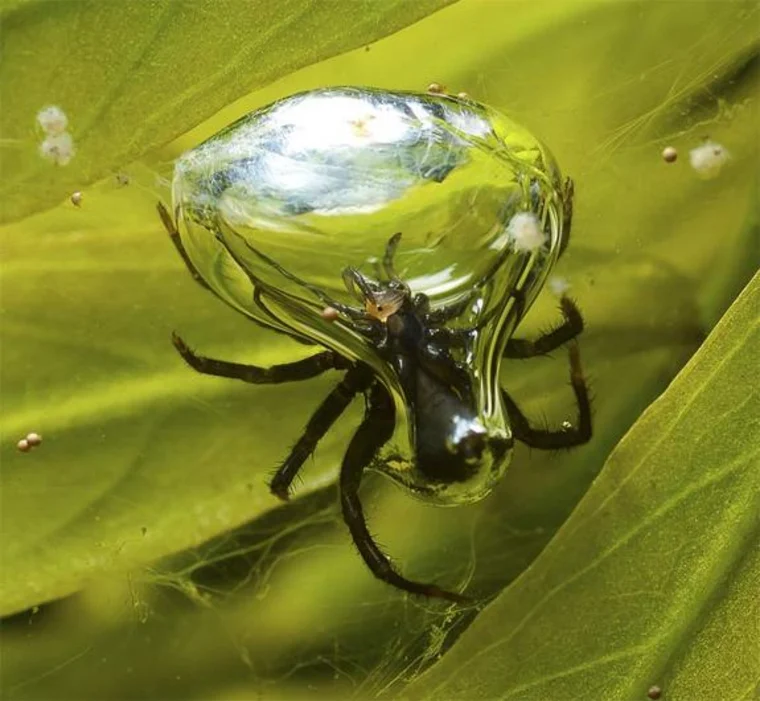Why do diving bell spider create bells?

Named for its peculiar behavior of constructing underwater air chambers resembling bells, the diving bell spider has fascinated scientists and nature enthusiasts alike for centuries. But why exactly do diving bell spiders create these remarkable structures?
The Diving Bell Spider
The diving bell spider, scientifically known as Argyroneta aquatica, holds a unique place in the world of arachnids. Unlike most spiders, which inhabit terrestrial environments, the diving bell spider has adapted to life in freshwater habitats, making it one of the few truly aquatic spider species on the planet.
These fascinating creatures can be found in various freshwater bodies across Europe and Asia, including ponds, lakes, slow-moving streams, and marshes. Their distribution extends from the British Isles and Scandinavia to parts of Russia, China, and Japan.
Diving bell spiders are relatively small, with females typically reaching lengths of around 9-15 millimeters, while males are slightly smaller. They have sleek bodies designed for efficient movement through water, with elongated legs and abdomens. Their coloration varies, ranging from dark brown to black, helping them blend into their aquatic surroundings and evade predators.
One of the most striking features of diving bell spiders is their ability to construct underwater air chambers, commonly referred to as diving bells. These structures play a crucial role in the spider’s survival in its aquatic environment, providing a source of oxygen for respiration.
The Construction of Diving Bells
To begin, the spider meticulously selects a suitable location within its aquatic habitat, often opting for submerged vegetation or submerged objects such as rocks or branches. With remarkable precision and agility, the spider begins the construction process by secreting silk from specialized glands located on its abdomen.
The silk produced by diving bell spiders is no ordinary material; it possesses unique properties that make it ideally suited for underwater construction. Unlike the silk used by their terrestrial counterparts for web-building, the silk of diving bell spiders is highly water-resistant and forms a flexible yet durable structure when submerged. This specialized silk serves as the building blocks for the diving bell bell.
Using its legs to manipulate and weave the silk threads, the spider carefully constructs a bell-shaped structure attached to the chosen substrate. The construction process is intricate and methodical, with the spider continuously adding layers of silk to reinforce the bell’s structure. As the bell takes shape, the spider strategically incorporates air bubbles into the silk threads, creating a network of pockets that will later serve as the bell’s oxygen reservoir.
Once the bell is complete, the spider meticulously seals any gaps or openings to ensure a watertight enclosure. This sealing process is crucial for maintaining the integrity of the bell and preventing water from entering and displacing the trapped air bubbles. With the construction finished, the diving bell spider now has a functional respiratory device that enables it to survive and thrive underwater.

The Purpose of Diving Bells
Now, the question arises: why do diving bell spiders go through the effort of constructing these elaborate structures?
Oxygen Reservoir
At the core of the diving bell bell’s function lies its role as a life-sustaining oxygen reservoir for the spider. As an air-breathing arachnid living in freshwater environments, the diving bell spider faces the challenge of obtaining sufficient oxygen while submerged.
By crafting the bell-shaped chamber from silk, the spider creates a sealed pocket of air that acts as a refuge, allowing it to access oxygen when submerged. This ingenious adaptation enables the spider to remain underwater for extended periods without needing to surface for air, thus facilitating its hunting and survival activities.
Protection from Predators
In addition to its respiratory function, the diving bell bell also serves as a protective refuge from predators. While underwater, the spider retreats into the bell when threatened, seeking safety within its air-filled confines. The structure’s shape and construction make it difficult for potential predators to access, providing the spider with a secure retreat where it can evade danger and await the opportune moment to resume its activities.
Temperature Regulation
Furthermore, the diving bell bell may play a role in temperature regulation for the spider. By trapping air within the silk threads, the bell creates a microenvironment that can insulate the spider from extreme temperature fluctuations in the surrounding water. This thermal buffer helps to maintain the spider’s physiological functions within optimal ranges, enhancing its overall fitness and survival in varying environmental conditions.
Reproductive Chamber
In some instances, the diving bell bell may also serve as a reproductive chamber for the spider. Female diving bell spiders have been observed laying their eggs within the confines of the bell, utilizing the protected environment to safeguard their offspring during the vulnerable early stages of development. This strategy not only ensures the survival of the spider’s progeny but also demonstrates the versatility and adaptability of the bell structure within the spider’s reproductive lifecycle.
Behavioral Signaling
Additionally, the presence of a diving bell bell may serve as a form of behavioral signaling within the spider’s social interactions. Male diving bell spiders have been observed constructing bells as part of courtship displays, potentially using the structure to attract and impress potential mates. The construction and maintenance of a well-constructed bell may serve as an indicator of the male spider’s fitness and reproductive prowess, influencing mate selection and breeding success.
Adaptations for Underwater Survival
The creation of diving bell bells is just one of several adaptations that enable diving bell spiders to thrive in aquatic environments. These spiders possess specialized hairs on their bodies that trap a thin layer of air, providing buoyancy and facilitating movement underwater. Additionally, their ability to survive prolonged periods without oxygen and their unique hunting techniques further contribute to their success as underwater predators.










